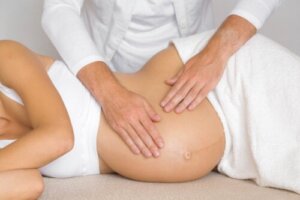Perineal Massage: How to Perform It

The perineum or pelvic floor plays a fundamental role during childbirth, and it’s important to prepare it during pregnancy. Perineal massage is a simple technique that promotes muscle elasticity and prevents tears and episiotomies.
This practice is highly recommended for women in their first pregnancy, to help them recognize their own bodies. However, other positive benefits have been demonstrated for mothers who have already had other children, and there are very few contraindications.
Here, in the following article, we’ll tell you how to put them into practice.
Recognition of the pelvic floor
Before practicing a perineal massage, you need to locate and recognize the area you’re going to work on. You can use a mirror to better visualize your pelvic floor or just feel it, becoming aware of all the structures that are in it.
Another very useful way to recognize the perineum is to sit on a pilates ball or cushion. Make sure that your feet make contact with the floor and that your knees are wide apart.
Put your pelvis in a neutral position and feel the muscles that come into contact with the surface of the ball. If you feel the area below the buttocks with both hands, you’ll see that it looks like a rhombus formed by the ischia on both sides, the pubis in front, and the coccyx behind. All this is the pelvic floor, and that’s where you’ll apply the massages.
Read more: 6 Basic Pelvic Floor Exercises for Pregnant Women
Step-by-step instructions for perineal massage in pregnancy
Perineal massage can be done every day, but in order for it to be effective, we recommend doing it at least once or twice a week.
For the massages, you’ll need a gliding medium, which can be pelvic floor-friendly oils (such as almond oil) or a water-based lubricant. If you wish, you can help yourself with a mirror to facilitate the recognition of the area.
Here are the step-by-step instructions for perineal massage.
1. Try to perform the massage in an intimate and comfortable space

The position you adopt will depend on your comfort. You can lie on your bed, half-sitting, with several pillows behind your back to relax. Another option is to sit on the toilet or lie down in the bathtub.
2. Recognize the area to be treated
After getting comfortable, begin to gently explore the perineal area. Put the cream or lubricant on your hands and pelvic floor so that the massage doesn’t cause discomfort. If you perform a self-massage, you’ll use your thumbs. If it’s another person who applies the massage, they’ll use their ring and middle fingers.
3. Start with the massages
To begin, you should insert your fingers at the entrance of the vagina, just a few centimeters (no more than 4). Gently slide them sideways, as if trying to enlarge the diameter of the cavity.
Then, do the same upward, in the direction of the urethra, but without going all the way to the urethra. If you can tolerate it, keep pressure on that area for about 3 to 4 minutes.
Finally, try to repeat this exercise at the opposite end, i.e. towards the anus. Place your fingers at the angle where the labia majora and labia minora meet. Hold the pressure for about 4 more minutes.
4. Give your muscles time and stay consistent
You may feel warmth or discomfort at first, but you’ll find that, over time, the area will begin to relax and loosen up. You’ll also begin to become familiar with some of the new sensations you’re likely to experience on the day of delivery.
You don’t need to do it all at once; it’s best to respect your own time and your body’s time. If, at any time, you feel pain, stop the massage and try again another time.
Learn more: The 4 Best Massages During Pregnancy

Precautions for perineal massage in pregnancy
Although perineal massage is a safe and simple technique, you must take into account some precautions when performing it.
The first consideration is not to perform them before the 34th week of gestation in order to avoid complications. Also, before starting them, talk to your doctor about it.
As for the technique, it’s important to do it gradually. First, start with external massages and then continue with internal massages, slowly and progressively increasing the pressure. It’s important to massage both areas to get the entire pelvic floor musculature to relax. Be sure to apply gentle but firm pressure so that it has an effect, without causing pain.
Finally, use a sufficient amount of lubricant to avoid damaging the area and maintain an adequate level of hydration every day. This way, your tissues will be healthy and strong to face the new stage that’s about to arrive.
The perineum or pelvic floor plays a fundamental role during childbirth, and it’s important to prepare it during pregnancy. Perineal massage is a simple technique that promotes muscle elasticity and prevents tears and episiotomies.
This practice is highly recommended for women in their first pregnancy, to help them recognize their own bodies. However, other positive benefits have been demonstrated for mothers who have already had other children, and there are very few contraindications.
Here, in the following article, we’ll tell you how to put them into practice.
Recognition of the pelvic floor
Before practicing a perineal massage, you need to locate and recognize the area you’re going to work on. You can use a mirror to better visualize your pelvic floor or just feel it, becoming aware of all the structures that are in it.
Another very useful way to recognize the perineum is to sit on a pilates ball or cushion. Make sure that your feet make contact with the floor and that your knees are wide apart.
Put your pelvis in a neutral position and feel the muscles that come into contact with the surface of the ball. If you feel the area below the buttocks with both hands, you’ll see that it looks like a rhombus formed by the ischia on both sides, the pubis in front, and the coccyx behind. All this is the pelvic floor, and that’s where you’ll apply the massages.
Read more: 6 Basic Pelvic Floor Exercises for Pregnant Women
Step-by-step instructions for perineal massage in pregnancy
Perineal massage can be done every day, but in order for it to be effective, we recommend doing it at least once or twice a week.
For the massages, you’ll need a gliding medium, which can be pelvic floor-friendly oils (such as almond oil) or a water-based lubricant. If you wish, you can help yourself with a mirror to facilitate the recognition of the area.
Here are the step-by-step instructions for perineal massage.
1. Try to perform the massage in an intimate and comfortable space

The position you adopt will depend on your comfort. You can lie on your bed, half-sitting, with several pillows behind your back to relax. Another option is to sit on the toilet or lie down in the bathtub.
2. Recognize the area to be treated
After getting comfortable, begin to gently explore the perineal area. Put the cream or lubricant on your hands and pelvic floor so that the massage doesn’t cause discomfort. If you perform a self-massage, you’ll use your thumbs. If it’s another person who applies the massage, they’ll use their ring and middle fingers.
3. Start with the massages
To begin, you should insert your fingers at the entrance of the vagina, just a few centimeters (no more than 4). Gently slide them sideways, as if trying to enlarge the diameter of the cavity.
Then, do the same upward, in the direction of the urethra, but without going all the way to the urethra. If you can tolerate it, keep pressure on that area for about 3 to 4 minutes.
Finally, try to repeat this exercise at the opposite end, i.e. towards the anus. Place your fingers at the angle where the labia majora and labia minora meet. Hold the pressure for about 4 more minutes.
4. Give your muscles time and stay consistent
You may feel warmth or discomfort at first, but you’ll find that, over time, the area will begin to relax and loosen up. You’ll also begin to become familiar with some of the new sensations you’re likely to experience on the day of delivery.
You don’t need to do it all at once; it’s best to respect your own time and your body’s time. If, at any time, you feel pain, stop the massage and try again another time.
Learn more: The 4 Best Massages During Pregnancy

Precautions for perineal massage in pregnancy
Although perineal massage is a safe and simple technique, you must take into account some precautions when performing it.
The first consideration is not to perform them before the 34th week of gestation in order to avoid complications. Also, before starting them, talk to your doctor about it.
As for the technique, it’s important to do it gradually. First, start with external massages and then continue with internal massages, slowly and progressively increasing the pressure. It’s important to massage both areas to get the entire pelvic floor musculature to relax. Be sure to apply gentle but firm pressure so that it has an effect, without causing pain.
Finally, use a sufficient amount of lubricant to avoid damaging the area and maintain an adequate level of hydration every day. This way, your tissues will be healthy and strong to face the new stage that’s about to arrive.
All cited sources were thoroughly reviewed by our team to ensure their quality, reliability, currency, and validity. The bibliography of this article was considered reliable and of academic or scientific accuracy.
- Salazar Criollo, Verónica Carolina. Investigación bibliográfica sobre la eficiencia del fortalecimiento de la musculatura de suelo pélvico por medio de ejercicios de kegel y masaje perineal durante el tercer trimestre de gestación en la prevención de desgarro perineal durante el parto, de grado no especificado. BS thesis. UCE. Quito. Año 2021. [Internet] Disponible en: http://www.dspace.uce.edu.ec/handle/25000/23758
- Madrid Prieto, Paloma. Masaje perineal y prevención de las lesiones tisulares y funcionales asociadas al parto. BS thesis. Año 2017. [Internet] Disponible en: https://repositorio.uam.es/handle/10486/680671
- Brasó, Victoria Noemí. Eficacia del masaje perineal antenatal para prevenir el trauma perineal y las episiotomías del parto: Una revisión sistemática. Trabajo final de grado. Facultad de enfermería y fisioterapia. Universidad de Lleida. Año 2016. [Internet] Disponible en: https://repositori.udl.cat/bitstream/handle/10459.1/58954/isolival.pdf?sequence=1#:~:text=CONCLUSI%C3%93N.,o%20realizaron%20ejercicios%20de%20Kegel.
- Otero Rodríguez, Marta. Utilización del masaje perineal durante el embarazo para evitar la realización de episiotomías. Trabajo final de grado. Facultad de enfermería y fisioterapia. Universidad de las Islas Baleares. Año 2019. [Internet] Disponible en: https://dspace.uib.es/xmlui/bitstream/handle/11201/150213/Otero_Rodriguez_Marta.pdf?sequence=1&isAllowed=y
- Landa Quintana, Maitane. Masaje perineal para evitar o reducir el corte de la episiotomía. Revisión bibliográfica. Trabajo final de grado en Fisioterapia. Universidad de Valladolid. Año 2018. [Internet] Disponible en: https://uvadoc.uva.es/handle/10324/31786
- Colás Carpallo, Sara. Masaje perineal prenatal: revisión narrativa. BS thesis. Año 2018. [Internet] Disponible en: https://repositorio.uam.es/bitstream/handle/10486/685190/colas_carpallo_saratfg.pdf?sequence=1&isAllowed=y
This text is provided for informational purposes only and does not replace consultation with a professional. If in doubt, consult your specialist.








